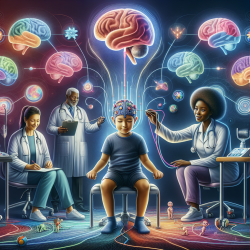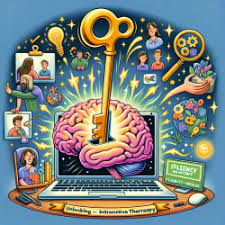Introduction to Electrical Brain Stimulation
Electrical Brain Stimulation (EBS) has been a cornerstone in neuroscience, providing insights into the functional mapping of the human brain. The comprehensive review by Selimbeyoglu and Parvizi (2010) offers a detailed examination of EBS's impact on perceptual and behavioral phenomena, drawing from over a century of research. This blog explores how these findings can be applied to speech-language pathology, particularly in online therapy settings like those provided by TinyEYE, to enhance outcomes for children.
Understanding EBS and Its Implications
EBS involves delivering electrical discharges to specific brain regions to observe their functional involvement in various cognitive processes. This method has been pivotal in identifying the necessity of certain brain areas in cognitive functions, offering a direct observation that complements neuroimaging techniques.
For speech-language pathologists, understanding the effects of EBS can inform strategies for addressing speech and language disorders. For instance, EBS studies have highlighted how stimulation of the frontal lobe can affect speech production, providing insights into potential therapeutic targets for interventions.
Key Findings Relevant to Speech-Language Pathology
- Frontal Lobe Stimulation: EBS in this region can lead to speech arrest and other disruptions in language processing, indicating its critical role in speech production and comprehension.
- Temporal Lobe Insights: Stimulation here can induce auditory hallucinations and changes in auditory perception, which are crucial for understanding language processing and auditory comprehension disorders.
- Parietal Lobe Contributions: Findings suggest involvement in sensory integration, which can affect how children process and respond to speech and language cues.
Applying EBS Insights in Online Therapy
For practitioners providing online therapy, integrating EBS findings can enhance intervention strategies. By understanding the neural underpinnings of speech and language functions, therapists can tailor their approaches to target specific cognitive processes more effectively. This data-driven approach ensures that interventions are grounded in robust scientific evidence, potentially improving outcomes for children.
Moreover, EBS findings can guide the development of new therapeutic tools and techniques, such as virtual reality environments or brain-computer interfaces, that leverage neural plasticity to facilitate language acquisition and recovery.
Encouraging Further Research
While EBS provides valuable insights, ongoing research is essential to fully understand its implications for speech-language pathology. Practitioners are encouraged to engage with current research, collaborate with neuroscientists, and contribute to studies that explore the application of EBS in therapeutic contexts.
To read the original research paper, please follow this link: Electrical Stimulation of the Human Brain: Perceptual and Behavioral Phenomena Reported in the Old and New Literature.










